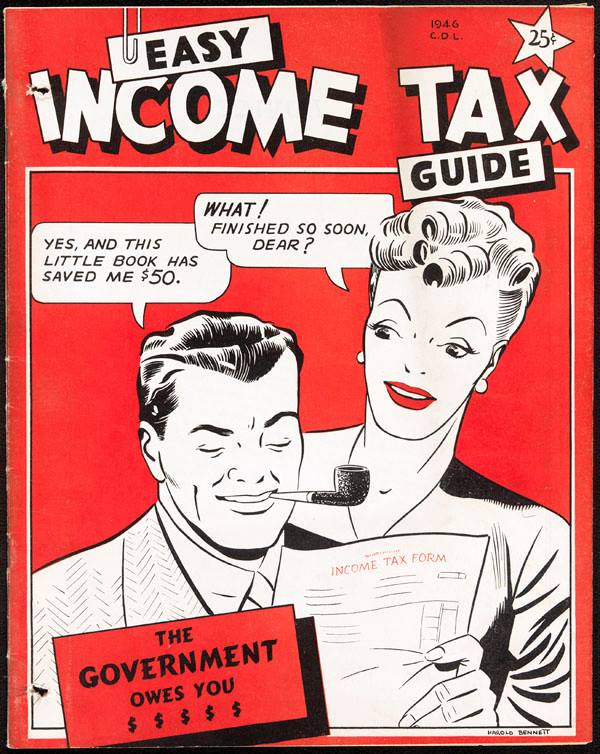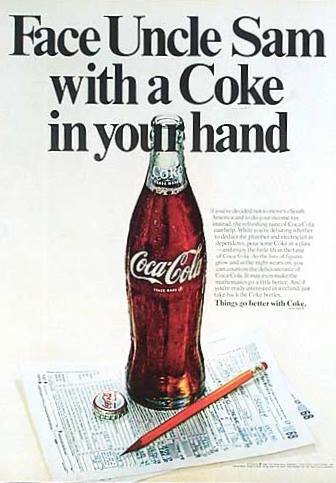Blog
“What we have now is democracy without citizens. No one is on
the public’s side. All the buyers are on the corporation’s side. And the bureaucrats in the Adminstration don’t think the government belongs to the people.” RALPH NADER
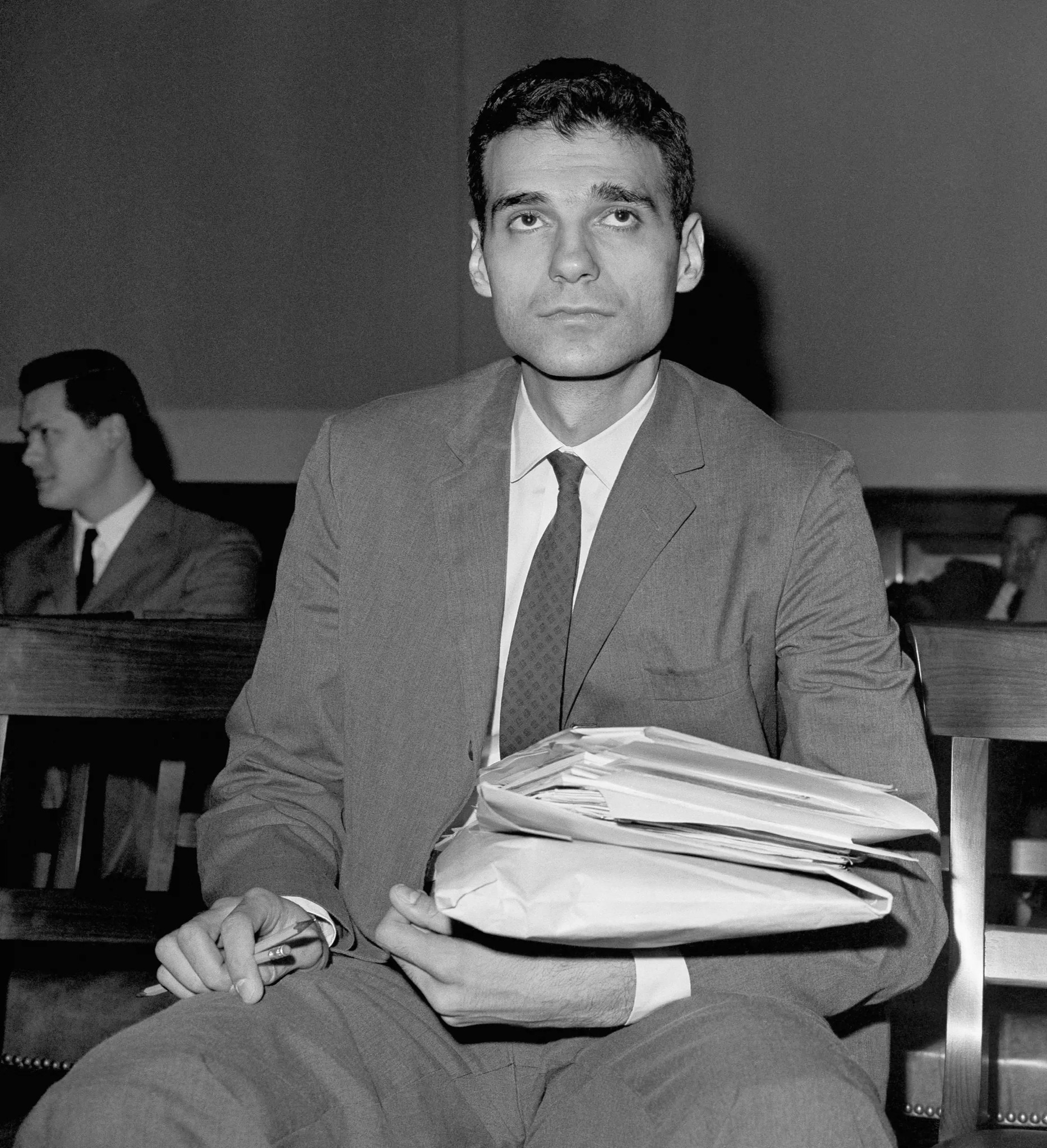
Frank Otis Frost (April 15, 1936 or 1938 – October 12, 1999) was one of the foremost American Delta blues harmonica players of his generation.
Most sources state that Frost was born in 1936 in Auvergne, Jackson County, Arkansas, though researchers Bob Eagle and Eric LeBlanc state Patterson, Woodruff County, in 1938. Frost began his musical career at a young age by playing the piano for his family church. At the age of 15, Frost left for St. Louis, where he became a guitarist. At the age of 18, Frost began touring with drummer Sam Carr and Carr’s father, Robert Nighthawk. Soon after touring, he toured again with Sonny Boy Williamson II for several years, who helped teach him how to play the harmonica.
more...Today’s rather aquatic-themed NASA/ESA Hubble Space Telescope Picture of the Week features the spiral galaxyMessier 77, also known as the Squid Galaxy, which sits 45 million light-years away in the constellation Cetus (The Whale).
The designation Messier 77 comes from the galaxy’s place in the famous catalogue compiled by the French astronomer Charles Messier. Another French astronomer, Pierre Méchain, discovered the galaxy in 1780. Both Messier and Méchain were comet hunters who catalogued nebulous objects that could be mistaken for comets.
Messier, Méchain, and other astronomers of their time mistook the Squid Galaxy for either a spiral nebula or a star cluster. This mischaracterisation isn’t surprising. More than a century would pass between the discovery of the Squid Galaxy and the realisation that the ‘spiral nebulae’ scattered across the sky were not part of our galaxy and were in fact separate galaxies millions of light-years away. The Squid Galaxy’s appearance through a small telescope — an intensely bright centre surrounded by a fuzzy cloud — closely resembles one or more stars wreathed in a nebula.
The name ‘Squid Galaxy’ only came about recently. This name comes from the extended, filamentary structure that curls around the galaxy’s disc like the tentacles of a squid. The Squid Galaxy is a great example of how advances in technology and scientific understanding can completely change our perception of an astronomical object — and even what we call it!
A Hubble image of the Squid Galaxy was previously released in 2013. This new version incorporates recent observations made with different filters and updated image processing techniques.
[Image Description: A close-up of a spiral galaxy, seen face-on. Its center glows brightly. From the sides of the galaxy’s core emerge spiral arms which wind through the round disc of the galaxy, filled with shining pink spots where stars are forming and more dark-red dust. Some faint stars can be seen around the galaxy, as well as a particularly bright star in the lower left of the image.]
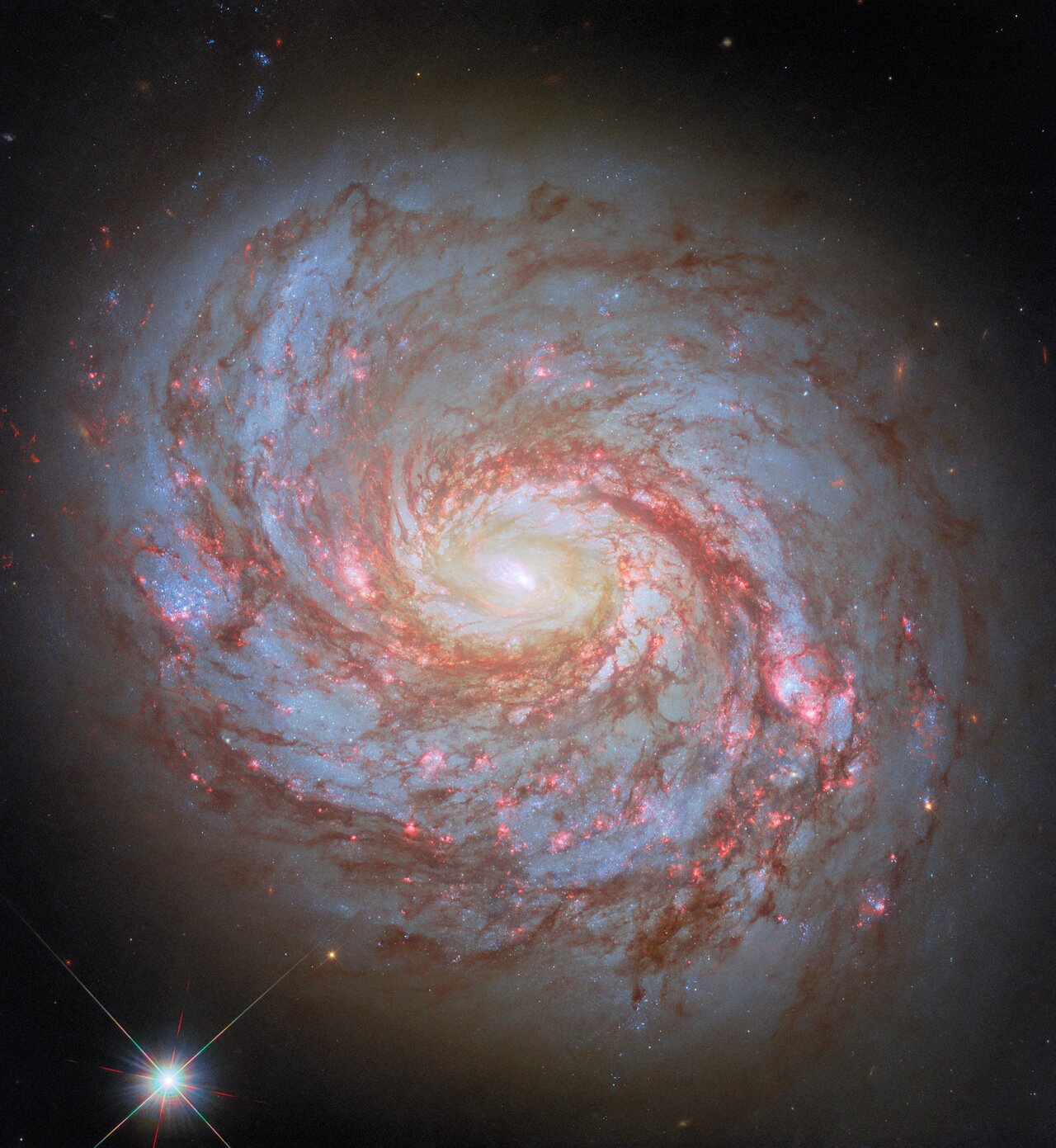
Jeff Golub (April 15, 1955 – January 1, 2015) was an American jazz guitarist who had a solo career and who led the band Avenue Blue. He worked as a sideman for a number of rock and pop musicians. He was arguably best known for his work with Rod Stewart.
more...Michael Arnold Kamen (April 15, 1948 – November 18, 2003 NY) was an American composer (especially of film scores), orchestral arranger, orchestral conductor, songwriter, record producer and musician. Kamen wrote eleven ballets, a saxophone concerto and an electric guitar concerto (with Japanese guitarist Tomoyasu Hotei as a soloist, though originally performed by Eric Clapton). Additionally, he wrote a commissioned work, “Quintet”, for the Canadian Brass. He also provided scores for the films 101 Dalmatians (1996), The Dead Zone, For Queen and Country, Polyester, Brazil, Someone To Watch Over Me, The Adventures of Baron Munchausen, The Three Musketeers, Highlander, X-Men, Robin Hood: Prince of Thieves, Licence to Kill, the Lethal Weapon series, the first three films of the Die Hard series, Mr. Holland’s Opus, The Iron Giant, Splitting Heirs, Frequency and many others. He also scored both the From the Earth to the Moon and Band of Brothers series on HBO. Trailers for the 2007 release Bee Movie, the 2008 release Nim’s Island, the 2008 release WALL-E, and the 2014 release Mr. Peabody & Sherman featured Kamen’s “Central Services / The Office” from his score to Brazil (1985).
more...Richard Davis (April 15, 1930 – September 6, 2023 Chicago) was an American jazz bassist. Among his best-known contributions to the albums of others are Eric Dolphy‘s Out to Lunch!, Andrew Hill‘s Point of Departure, and Van Morrison‘s Astral Weeks, of which critic Greil Marcus wrote (in The Rolling Stone Illustrated History of Rock and Roll), “Richard Davis provided the greatest bass ever heard on a rock album.”
more...Annapurna Devi (17 April 1927 – 13 October 2018) was an Indian surbahar player of Hindustani classical music. She was given the name ‘Annapurna’ by Maharaja Brijnath Singh of the former Maihar Estate, and it was by this name that she was popularly known. She was the daughter and disciple of Allauddin Khan, and the sister of Ustad Ali Akbar Khan. Pandit Ravi Shankar was her first husband, with whom she had a son, Shubhendra Shankar, who was an artist and a sitarist.
She was an extremely private person and was never interested in being a professional musician like the rest of her family. However, she was active throughout her life as a teacher to many other prominent musicians like Nikhil Banerjee, Hariprasad Chaurasia, Nityanand Haldipur, Sudhir Phadke and Sandhya Phadke. She was the only known female maestro of the surbahar in the 20th century.
more...Irving Herbert Pomeroy III (April 15, 1930 – August 11, 2007) was an American jazztrumpeter, teacher, and the founder of the MIT Festival Jazz Ensemble. Remaining in Boston, he played with Charlie Parker for one week in 1953, then briefly with Charlie Mariano, before going on tour with Lionel Hampton and Stan Kenton. Back in Boston, he played with Serge Chaloff and was hired to teach at Schillinger after it had been renamed the Berklee School of Music. During the latter part of the 1950s he was the leader of a sixteen-piece band which included Mariano, Bill Berry, Jaki Byard, Joe Gordon, and Boots Mussulli. For two years after that, he led another band, which included Alan Dawson, Hal Galper, Michael Gibbs, Dusko Goykovich, and Sam Rivers. He worked in pit orchestras for Broadway shows passing through Boston. Beginning in 1963 he led bands at the Massachusetts Institute of Technology. He led a band until 1993, two years before retiring from Berklee.
more...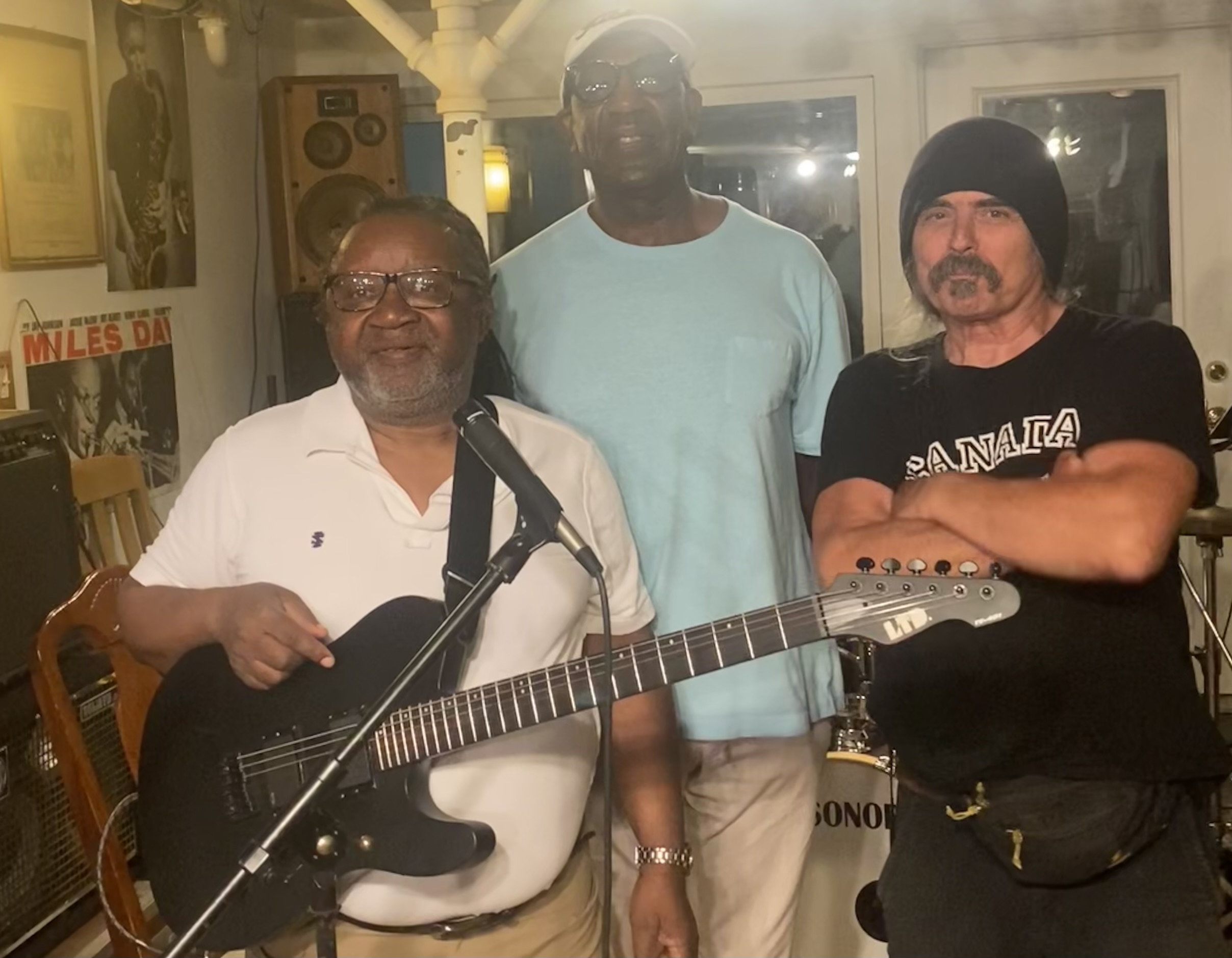
It’s hard to tell with optical telescopes since visible light is blocked by intervening interstellar dust. In other bands of light, though, such as radio, the galactic center can be imaged and shows itself to be quite an interesting and active place. The featured picture shows an image of our Milky Way’s center by the MeerKAT array of 64 radio dishes in South Africa. Spanning four times the angular size of the Moon (2 degrees), the image is impressively vast, deep, and detailed. Many known sources are shown in clear detail, including many with a prefix of Sgr, since the galactic center is in the direction of the constellation Sagittarius. In our galaxy’s center lies Sgr A, found here in the image center, which houses the Milky Way’s central supermassive black hole. Other sources in the image are not as well understood, including the Arc, just to the left of Sgr A, and numerous filamentary threads. The inset image shows a small patch recently imaged in infrared light with the James Webb Space Telescope to investigate the effects of magnetic fields on star formation.
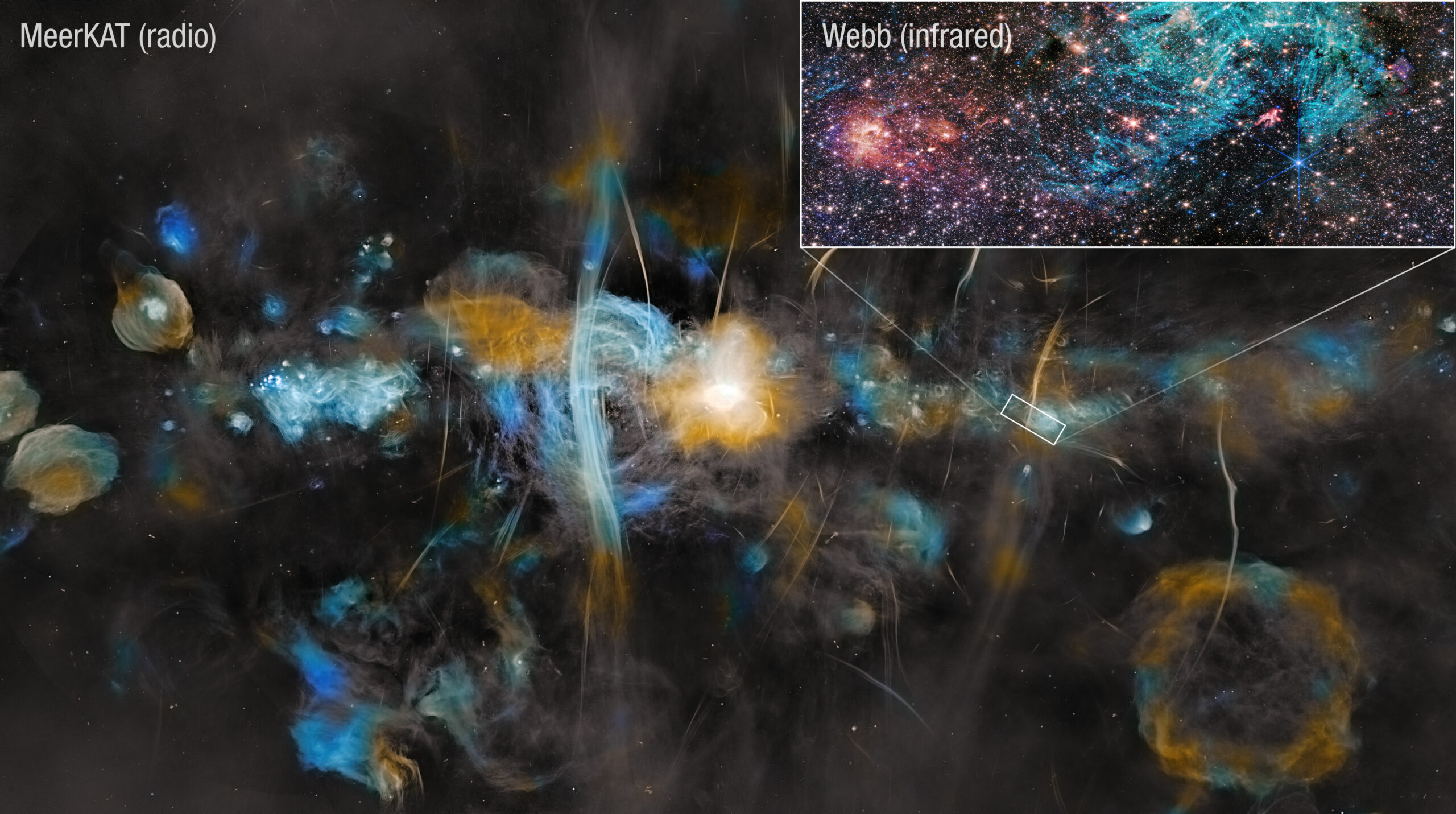
Richard Hugh Blackmore (born 14 April 1945) is an English guitarist. He was a founding member and the lead guitarist of Deep Purple, playing jam-style hard rockmusic that mixed guitar riffs and organ sounds. After leaving Deep Purple in 1975, Blackmore formed the hard rock band Rainbow, which fused baroque musicinfluences and elements of hard rock. Rainbow steadily moved to catchy pop-style mainstream rock. Rainbow broke up in 1984 with Blackmore re-joining Deep Purple until 1993. In 1997, he formed the traditional folk rock project Blackmore’s Night along with his current wife Candice Night, shifting to vocalist-centred sounds.
He is prolific in creating guitar riffs and has been known for playing both classically influenced and blues-based solos. As a member of Deep Purple, Blackmore was inducted into the Rock and Roll Hall of Fame in April 2016. He is cited by publications such as Guitar World and Rolling Stone as one of the greatest and most influential guitar players of all time.
more...Zéphyrin-Alexandre Matima Mpioso (14 April 1951 – 26 May 1996), known professionally as
Mbuta Matima, was a prominent Congolese guitarist, arranger, music director and songwriter, best known for his influential work with Zaïko Langa Langa, one of the most famous and enduring bands of Congolese rumba.
Born in Sona-Bata, a town in the Bas-Congo Province, Matima began his musical career in 1969, debuting with Orchestre Stukas. In 1969, he joined Zaïko Langa Langa, initially as part of their pop section, performing as a concert opener alongside singers Mbuta Mashakado and Pierre Nkumu. Matima’s transition to the band’s main Congolese rumba section came in 1973 when singer Gina wa Gina Efonge encouraged him to play the guitar in place of the band’s lead guitarist, Félix Manuaku Waku. Matima’s first guitar solos featured in Efonge’s song “BP Ya Munu,” released in December 1973. His own first composition for Zaïko Langa Langa, “Ngeli Ngeli” (later versioned as “Kin Kiesse”),[2] was recorded for the band’s 1976 LP Plaisir de l’Ouest Afrique. In late 1976, he released another classic hit, “Toli Kulumpe,” which was reversioned in 1977 and again in 1982. In 1978, Matima was part of Tout Grand Libanko, a nzonzing band by Gina wa Gina parallel to his career in Zaïko Langa Langa.
Following Manuaku’s departure in 1980, Matima assumed greater responsibilities within the band as the artistic director and arranger. He played a crucial role in song composition and arrangement, significantly shaping the band’s musical direction. One of his notable compositions, “Masela,” appeared on Zaïko Langa Langa’s 1984 LP On Gagne Le Procès. He also released classics like “Kabobo” and “Mena,” which featured on the albums Tala Modèle Echanger (1985) and Pusa Kuna… Serrez! Serrez! (1986), respectively. Matima’s skills as an arranger shone in the album Nippon Banzai, considered Zaïko Langa Langa’s most successful and popular record.
In May 1988, a split within Zaïko Langa Langa led to the formation of Zaïko Langa Langa Familia Dei. Matima chose to remain with the original band. They released the LP Jetez l’Eponge in 1989. In Zaïko Langa Langa’s 1991 LP Jamais sans Nous, Matima composed his final song for the band, “Reviens Hyppau,” and played lead guitar on “Videma.
more...Charles Michael Brewer (April 14, 1944 – December 17, 2024) was an American musician. He and Tom Shipley were the music duo Brewer & Shipley.
Brewer formed a duo in Los Angeles during early 1966 named Mastin & Brewer with singer/songwriter Tom Mastin. The group recruited drummer Billy Mundi and bass guitar player Jim Fielder for live performances, opening for The Byrds and Buffalo Springfield during spring 1966. When Mastin left during sessions for an album, Brewer enlisted his brother Keith and the pair recorded a lone single 45 for Columbia Records, “Need You”, backed by “Rainbow” (written by Tom Mastin and Brewer before the former’s departure). Mundi became employed with The Lamp of Childhood and then The Mothers of Invention while Fielder had also joined The Mothers of Invention (and later Buffalo Springfield and Blood, Sweat & Tears). After recording the single, Brewer met his old friend Tom Shipley and they initiated a duo together.
more...Ali Akbar Khan (14 April 1922 – 18 June 2009) was an Indian Hindustani classical musician of the Maihar gharana, known for his virtuosity in playing the sarod. Trained as a classical musician and instrumentalist by his father, Allauddin Khan, he also composed numerous classical ragas and film scores. He established a music school in Calcutta in 1956, and the Ali Akbar College of Music in 1967, which moved with him to the United States and is now based in San Rafael, California, with a branch in Basel, Switzerland.
Khan was instrumental in popularizing Indian classical music in the West, both as a performer and as a teacher. He first came to America in 1955 on the invitation of violinist Yehudi Menuhin and later settled in California. He was a adjunct professor of music at the University of California, Santa Cruz.
Khan was accorded India’s second highest civilian honour, the Padma Vibhushan, in 1989. Nominated five times for the Grammy Award, Khan was also a recipient of the MacArthur Fellowship and the National Endowment for the Arts‘ National Heritage Fellowship.
more...Eugene “Jug” Ammons (April 14, 1925 – August 6, 1974), also known as “The Boss”, was an American jazz tenor saxophonist. The son of boogie-woogie pianist Albert Ammons, Gene Ammons is remembered for his accessible music, steeped in soul and R&B.
Born in Chicago, Illinois, Ammons studied music with instructor Walter Dyett at DuSable High School. Ammons began to gain recognition while still at high school when in 1943, at the age of 18, he went on the road with trumpeter King Kolax‘s band. In 1944, he joined the band of Billy Eckstine (who bestowed on him the nickname “Jug” when straw hats ordered for the band did not fit), playing alongside Charlie Parker and later Dexter Gordon. Performances from this period include “Blowin’ the Blues Away,” featuring a saxophone duel between Ammons and Gordon. After 1947, when Eckstine became a solo performer, Ammons then led a group, including Miles Davis and Sonny Stitt, that performed at Chicago’s Jumptown Club. In 1949, Ammons replaced Stan Getzas a member of Woody Herman‘s Second Herd, and then in 1950 formed a duet with Sonny Stitt.
more...More Posts
- Shotgun Wedding: Oh Death – White Wedding @ Village of Terror Chippewa Falls, WI 2011
- Bates Motel Orchestra: “Hell” Halloween @ @ Village of Terror Chippewa Falls, WI 2010
- Songs for Diego CD Release @ Cedar Cultural Center 2007
- Voices of Sepharad at Center for Independent Artists 8-2-2004 with David Harris, David Stenshoel, David Burk and the undavid Mick LaBriola
- 2017 Minnesota Renaissance Festival Drum Jam 2 with Drum Maestro mick LaBriola
- 2017 Minnesota Renaissance Festival Drum Jam with Drum Maestro mick laBriola
- Barry Rogers Day
- Elek Bacsik Day
- Sun Ra Day
- World Music with Muhlis Berberoğlu & Burakhan Nur
- Daily Roots with Bobby Aitken and the Carib Beats
- Senegalese Bassist Habib Faye passes 4-25-18
- The Cosmos with NGC 6193/6188
- Larance Marable Day
- Little Willie Anderson Day
- Fats Waller Day
- World Music with Habib Faye
- Daily Roots with Hopeton Lewis
- The Cosmos with NGC 2070
- Joe Cocker Day

